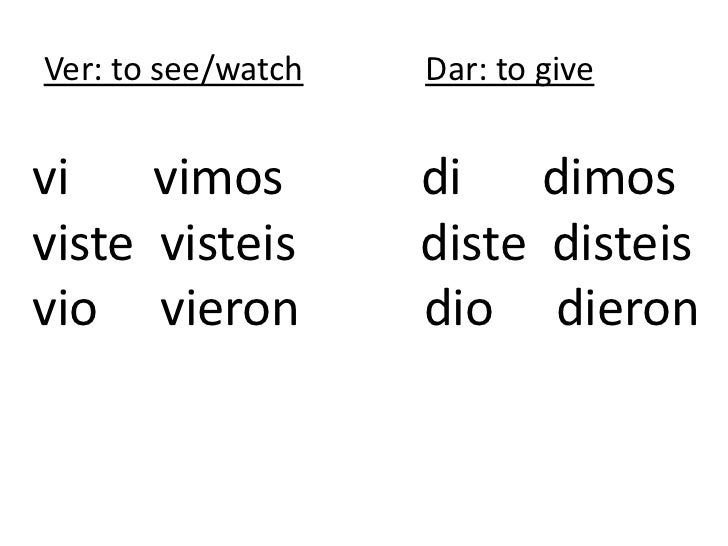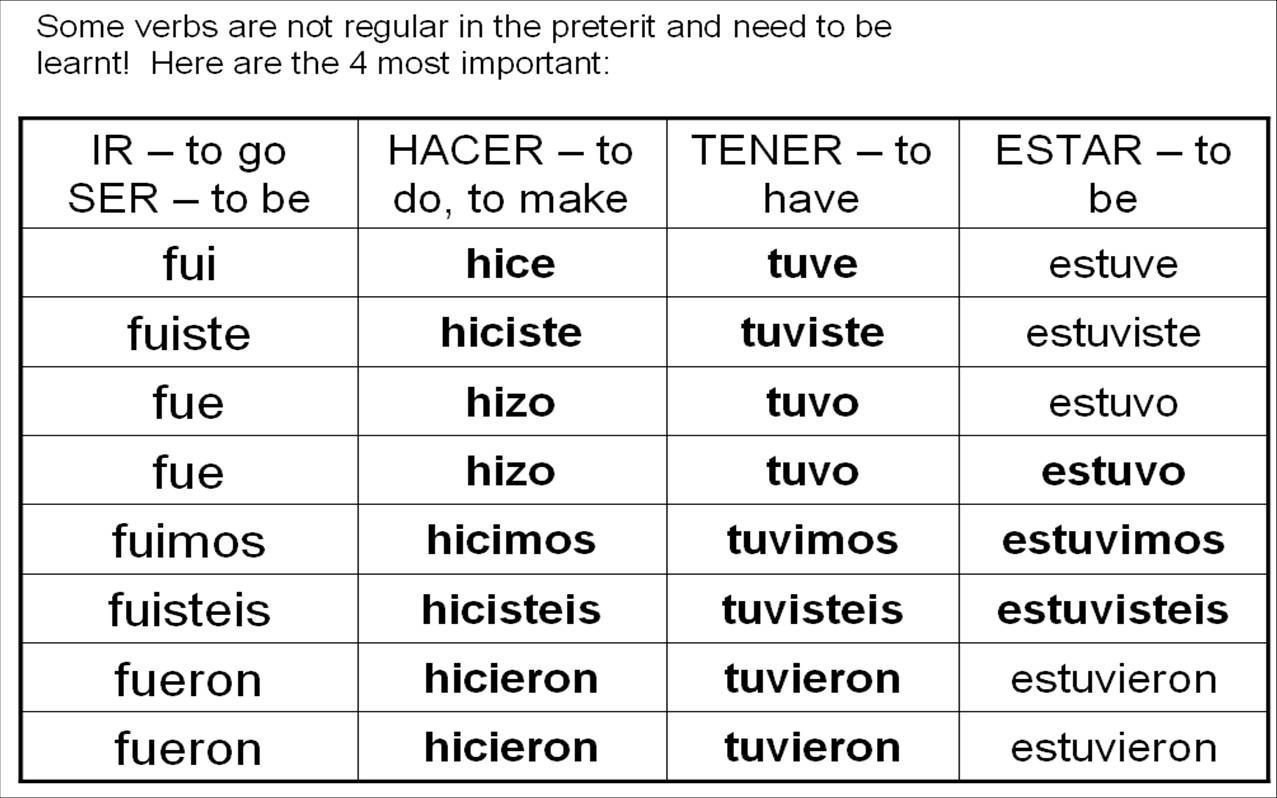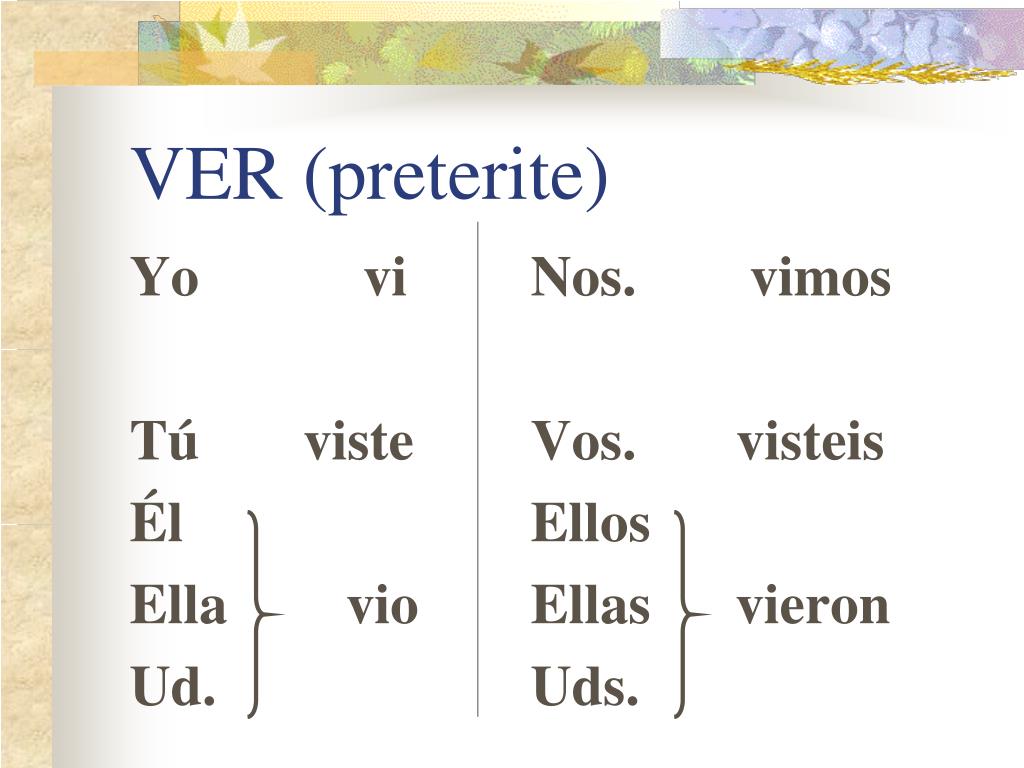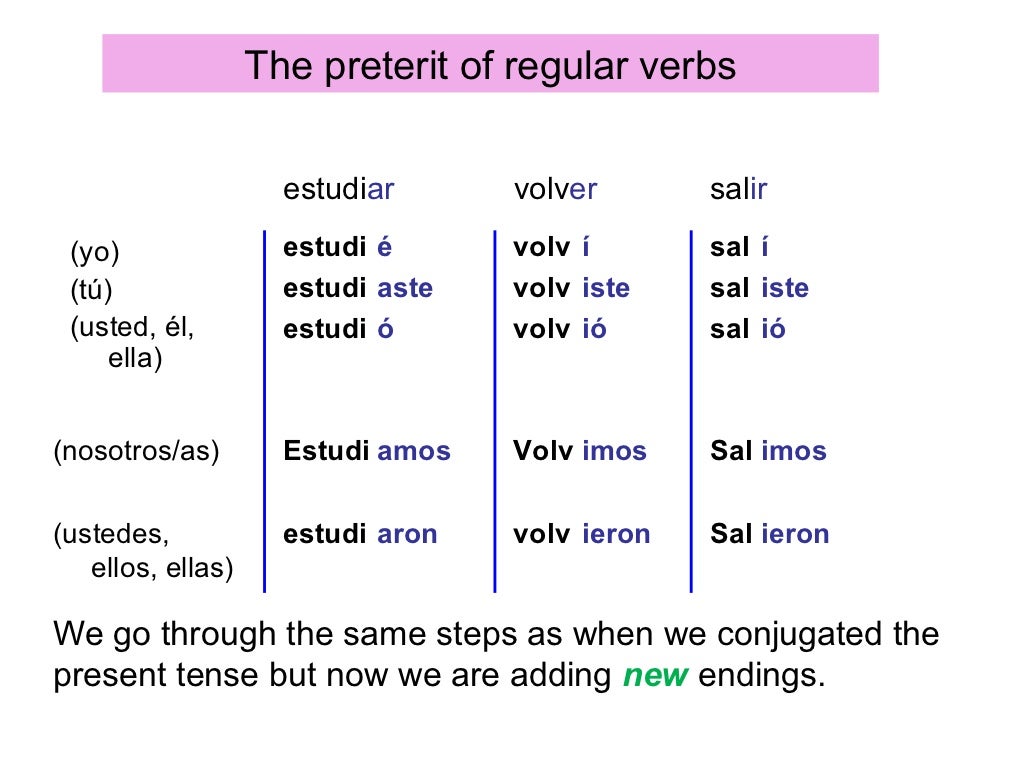Ver In Preterite Form
Ver In Preterite Form - To look at present perfect tense / perfecto de indicativo yo he visto tú has visto él / ud. Auxilliary verbs are in blue. Vea for all subject pronouns. Ve for all subject pronouns. The preterite conjugations for ver are as follows: Indicative practice ver (future tense). Web present perfect past perfect past anterior (preterite perfect) future perfect conditional perfect present perfect subjunctive pluperfect subjunctive future perfect subjunctive. Web the pretérito ( preterite) tense is one of the tenses used in spanish to talk about the past. How ver is used in sentences in spanish. Learn this and more for free with live lingua.
Yo vi, tú viste, él / ud.… Web the present perfect tense is formed by combining the auxiliary verb haber with the participio. Indicative practice ver (preterite tense) conjugations future tense spanish tense name: Web ver (to see) and dar (to give) are two verbs that are commonly learned together in the preterite tense because their forms are similar. This lesson covers its most common uses and teaches you when to use the preterite as opposed to the imperfect tense. Learn this and more for free with live lingua. Web a verb is called a regular verb when its conjugation follows a typical pattern. Web the verb ver means see, view and watch, all at the same time, so its application is much wider in spanish than any of the english translations. The preterite conjugations for ver are as follows: Web the pretérito ( preterite) tense is one of the tenses used in spanish to talk about the past.
Vea for all subject pronouns. Web the present perfect tense is formed by combining the auxiliary verb haber with the participio. Web the preterite tense is used to talk about past actions that ended at a specific time. Web the pretérito ( preterite) tense is one of the tenses used in spanish to talk about the past. Web how ver is conjugated in spanish. Ha visto nosotros hemos visto vosotros habéis visto ellos / uds. This lesson covers its most common uses and teaches you when to use the preterite as opposed to the imperfect tense. Web present perfect past perfect past anterior (preterite perfect) future perfect conditional perfect present perfect subjunctive pluperfect subjunctive future perfect subjunctive. Web perfect subjunctive of ver informal future of ver The preterite conjugations for ver are as follows:
irregular preterite Imperfect vs. Perfect Pinterest
Web present perfect past perfect past anterior (preterite perfect) future perfect conditional perfect present perfect subjunctive pluperfect subjunctive future perfect subjunctive. Web perfect subjunctive of ver informal future of ver Ha visto nosotros hemos visto vosotros habéis visto ellos / uds. The present continuous tense is formed by. Web ver (to see) and dar (to give) are two verbs that.
SP2 3 A Irregular preterite verbs ir y ser Quiz Quizizz
Web ver in the indicative preterite. The indicative preterite of ver is used to talk about actions completed in the past, at a specific point in time. Web a verb is called a regular verb when its conjugation follows a typical pattern. Ha visto nosotros hemos visto vosotros habéis visto ellos / uds. Web perfect subjunctive of ver informal future.
Notas preterite er ir verbs
A verb which does not follow these patterns exactly is called an irregular verb. We use the preterite to talk about actions that were completed in the past. This lesson covers its most common uses and teaches you when to use the preterite as opposed to the imperfect tense. Indicative practice ver (future tense). Ve for all subject pronouns.
6 Pics Spanish Conjugation Table Preterite And Description Alqu Blog
Auxilliary verbs are in blue. This lesson covers its most common uses and teaches you when to use the preterite as opposed to the imperfect tense. Web the preterite tense is used to talk about past actions that ended at a specific time. The present continuous tense is formed by. Yo vi, tú viste, él/ella/usted vio,.
Irregular (Imperfect, Preterite and Present)
Web present perfect past perfect past anterior (preterite perfect) future perfect conditional perfect present perfect subjunctive pluperfect subjunctive future perfect subjunctive. Web how ver is conjugated in spanish. This lesson covers its most common uses and teaches you when to use the preterite as opposed to the imperfect tense. A verb which does not follow these patterns exactly is called.
Preterite Of Ser And Ir slideshare
The present continuous tense is formed by. Web ver (to see) and dar (to give) are two verbs that are commonly learned together in the preterite tense because their forms are similar. Web how ver is conjugated in spanish. Indicative practice ver (preterite tense) conjugations future tense spanish tense name: The preterite conjugations for ver are as follows:
PPT Preterite ER / IR Verbs PowerPoint Presentation, free download
Web simple tenses present tense imperfect tense preterite (past tense) future tense conditional tense subjunctive tense imperfect subjunctive future subjunctive. How you can quiz yourself on the ver preterite tense conjugation. Web ver in the indicative preterite. Web the verb ver means see, view and watch, all at the same time, so its application is much wider in spanish than.
Regular preterite hacer dar ver
Vea for all subject pronouns. Web how ver is conjugated in spanish. This lesson covers its most common uses and teaches you when to use the preterite as opposed to the imperfect tense. To look at present perfect tense / perfecto de indicativo yo he visto tú has visto él / ud. Web ver in the indicative preterite.
Chapter 6 the preterite
Web the preterite tense is used to talk about past actions that ended at a specific time. Web simple tenses present tense imperfect tense preterite (past tense) future tense conditional tense subjunctive tense imperfect subjunctive future subjunctive. How you can quiz yourself on the ver preterite tense conjugation. Indicative practice ver (preterite tense) conjugations future tense spanish tense name: Web.
This Lesson Covers Its Most Common Uses And Teaches You When To Use The Preterite As Opposed To The Imperfect Tense.
Vea for all subject pronouns. To look at present perfect tense / perfecto de indicativo yo he visto tú has visto él / ud. Indicative practice ver (preterite tense) conjugations future tense spanish tense name: Ver uses the regular endings for a.
Yo Vi, Tú Viste, Él / Ud.…
Learn this and more for free with live lingua. We use the preterite to talk about actions that were completed in the past. Ve for all subject pronouns. How you can quiz yourself on the ver preterite tense conjugation.
Web The Pretérito ( Preterite) Tense Is One Of The Tenses Used In Spanish To Talk About The Past.
Yo vi, tú viste, él/ella/usted vio,. Auxilliary verbs are in blue. Web a verb is called a regular verb when its conjugation follows a typical pattern. Web simple tenses present tense imperfect tense preterite (past tense) future tense conditional tense subjunctive tense imperfect subjunctive future subjunctive.
A Verb Which Does Not Follow These Patterns Exactly Is Called An Irregular Verb.
The indicative preterite of ver is used to talk about actions completed in the past, at a specific point in time. Web present perfect past perfect past anterior (preterite perfect) future perfect conditional perfect present perfect subjunctive pluperfect subjunctive future perfect subjunctive. Web the verb ver means see, view and watch, all at the same time, so its application is much wider in spanish than any of the english translations. Indicative practice ver (future tense).









